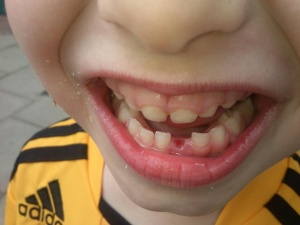Wobbly Teeth
Losing a baby tooth
This can be an exciting time to find you have a wobbly tooth, but for some children it can be quite daunting and scary experience.
I know when my son’s first tooth became wobbly he was terrified; the thought of having this big hole in his mouth really upset him, never mind the thought that it might hurt. Once he realised there was no pain involved he loved it, he would sit for hours playing with his tooth, wobbling it one way then the next, seeing how far forward it would go.
His first tooth fell out during an afternoon at the seaside, unfortunately for us we didn't get to keep it for his memory box as he ate it. Yep, he was nicely enjoying his dinner, he didn't even realise at first it wasn't until he spoke and we notice the gap in his teeth. As you can see from the photo he was very happy to show it off.
The Tooth Fairy
For me, all children including my own must have the excitement of the tooth fairy coming to visit them whilst they're asleep. We also bought a book that we could read to him on the night before he went to sleep, I believe it was a Peppa Pig book, it gave him instructions to brush his newly fallen out tooth and provided a little letter and envelope to put it in, and also one for the parents to put some small change in when they are asleep. Jake was so excited when he got up in the morning to find the fairy had been and left him some pennies. We had to write the tooth fairy a letter about him swallowing his first tooth so she would still come to see him! But we did manage to keep his second for the memory box we keep for all his little trinkets.
So when do They Start Becoming Loose?
Normally around the age of 5-6 years you would expect to see movement of teeth, but this can sometimes be as early as 4 years or as late as 7 years. They can become loose before this time, even as young at 3 years. If this happens, a dentist’s visit is recommended as they may want to fit a spacer between the teeth to prevent any movement of the adult teeth below the gum line, and to make sure they come through in the best of health. This will also be considered if an accident has occurred and they have broken or lost a tooth.
Teeth normally become wobbly and fall out in the same order they came in. The bottom front teeth are generally first, followed by the top 2 front teeth.
Encourage your child to wobble their tooth but not to pull on it. Wobbling the tooth actually helps to free it, but pulling a tooth before its ready can increase the chance of infection.
Also at around the same time, as those first adult teeth appear, your child may talk about pain in the back area of his mouth, this is probably due to their adult molars coming through. There are no baby teeth here to lose first, so general teething pain can be felt at this time along with a slight temperature. Pain relief may be advisable if appropriate to use. This is your decision.
It is quite common for a child’s adult teeth to appear before losing their milk teeth and this is known as shark teeth (it form’s two rows of teeth back to back). This is usually a temporary thing, but if you are concerned speak to your dentist.
Around the age of 12-13 their last milk teeth should be becoming loose and replaced by their permanent teeth. Also around this time they will get their last pair of molars.
--Kerryflump (talk)  10:36, 4 May 2013 (UTC)
10:36, 4 May 2013 (UTC)
